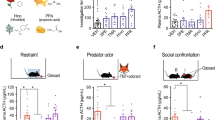Abstract
Corticosterone and prolactin do not reflect the alarm pheromone effect in the rat. Male rats were immersed in water previously swum in by 0, 1, or 2 other rats. Immobility decreased considerably after immersion in water previously swum in by one animal and did not decline further because of a “floor effect.” Plasma corticosterone levels were increased by immersion in both fresh and soiled water. Prolactin levels were not increased significantly. Water condition did not significantly affect plasma corticosterone or prolactin levels when rats were sacrificed immediately after testing or 20 min after testing. These results indicate that neither corticosterone nor prolactin mediate the alarm pheromone phenomenon.
Similar content being viewed by others
References
Abel, E.L. 1991a. Gradient of alarm substance in the forced swimming test.Physiol. Behav. 49:321–323.
Abel, E.L. 1991b. Behavior and corticosteroid response of Maudsley reactive and nonreactive rats in the open field and forced swimming test.Physiol. Behav. 50:151–153.
Abel, E.L. 1991c. Alarm substance emitted by rats in the forced swim test is a low volatile pheromone.Physiol. Behav. In press.
Abel, E.L., andBilitzke, P.J. 1990. A possible alarm substance in the forced swimming test.Physiol. Behav. 48:233–239.
Ader, R. 1970. The effects of early experience on the adrenocortical responses to different magnitudes of stimulation.Physiol. Behav. 5:837–839.
Amario, A., Montero, J.L., andBalasch, J. 1986. Sensitivity of corticosterone and some metabolic variables to graded levels of low intensity stresses in adult males.Physiol. Behav. 37:559–561.
Axelrod, J., andReisine, T.D. 1984. Stress hormones: Their interaction and regulation.Science 224:452–459.
Borsini, F., andMeli, A. 1988. Is the forced swimming test a suitable model for revealing antidepressant activity?Psychopharmacology 94:147–160.
Borsini, F., Lecci, A., Sessarego, A., Frassine, R. andMeli, A. 1989. Discovery of antidepressant activity by forced swimming test may depend on pre-exposure of rats to a stressful situation.Psychopharmacology 97:183–188.
Brown, G.M., andMartin, J.B. 1974. Corticosterone, prolactin, and growth hormone responses to handling and new environment in the rat.Psychosom. Med. 36:241–247.
Gala, R.R. 1990. The physiology and mechanisms of the stress-induced changes in prolactin secretion in the rat.Life Sci. 46:1407–1420.
Hawkins, J.D., Hicks, R.A., Phillips, N., andMoore, J.D. 1978. Swimming rats and human depression.Nature. 274:512.
Hennessey, M.B., Heybach, J.P., Vermikos, J., andLevine, S. 1979. Plasma corticosterone concentrations sensitivity reflect levels of stimulus intensity in the rat.Physiol. Behav. 22:821–825.
Kant, G.J., Mougey, E.H., Pennington, L.L., andMeyerhoff, J.L. 1983. Graded foot shock stress elevates pituitary cyclic AMP and plasma β-LPH, corticosterone and prolactin.Life Sci. 33:2657–2663.
Mackay-Sim, A., andLaing, D.G. 1980. Discrimination of odors from stressed rats by nonstressed rats.Physiol. Behav. 24:699–704.
Porsolt, R.D., Lepichon, M. andJolfe, M. 1977. Depression: A new animal model sensitive to antidepressant treatments.Nature 266:730–732.
Satoh, T., Yamada, K. andTsuboi, M. 1985. Effect of imipramine on serum corticosterone levels in the forced swimming rats.Res. Commun. Psychol. Psychiatr. Behav. 10:235–238.
Seggie, J.A., andBrown, G.M. 1975. Stress response patterns of plasma corticosterone, prolactin, and growth hormone in the rat, following handling or exposure to novel environment.Can. J. Physiol. Pharmacol. 53:629–637.
Subramanian, M.G., andAbel, E.L. 1988. Alcohol inhibits suckling-induced prolactin release and milk yield.Alcohol 5:95–98.
West, A.P. 1990. Neurobehavioral studies of forced swimming: The role of learning and memory in the forced swim test.Prog. Neurol. Psychopharmacol. Biol. Psychiatr. 14:863–877.
Author information
Authors and Affiliations
Rights and permissions
About this article
Cite this article
Abel, E.L., Subramanian, M.G. Corticosterone and prolactin do not mediate alarm pheromone effect in the rat. J Chem Ecol 17, 2155–2161 (1991). https://doi.org/10.1007/BF00987998
Received:
Accepted:
Issue Date:
DOI: https://doi.org/10.1007/BF00987998




